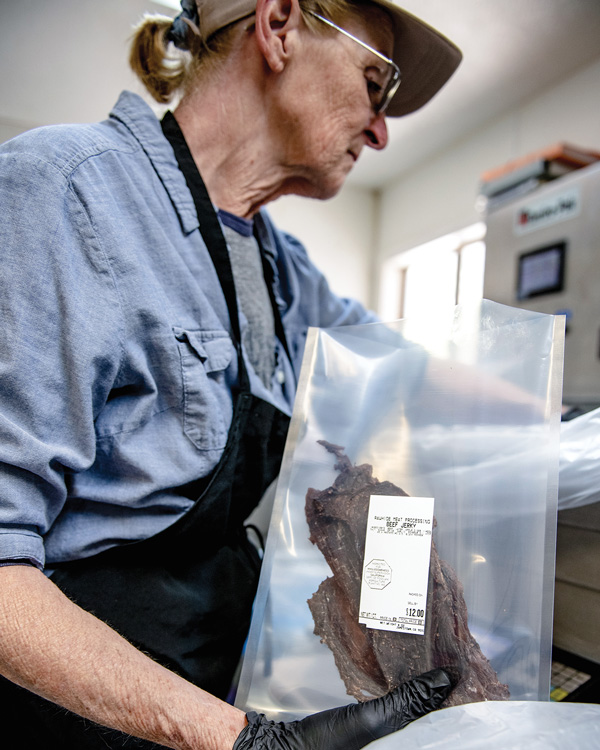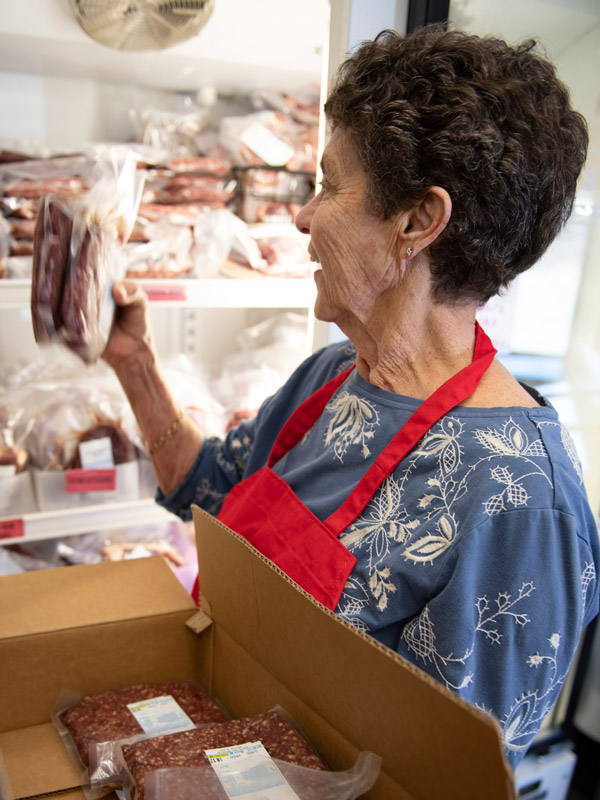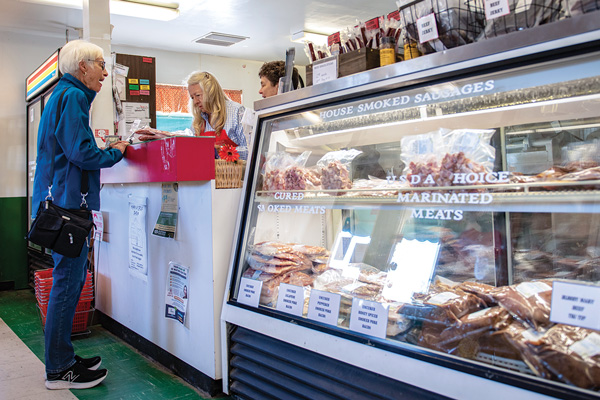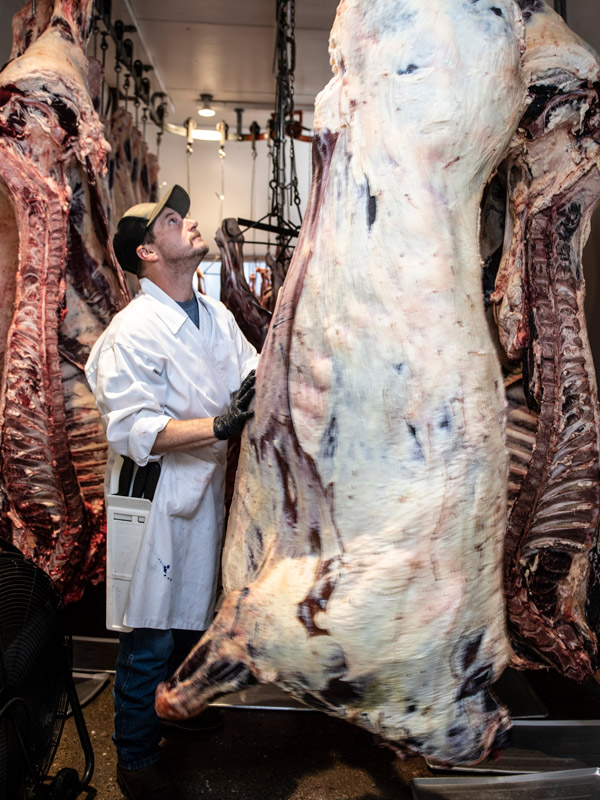Making the cut

March/April 2023 California Bountiful magazine

Ranch families boost community with locally raised, processed beef
Story by Caleb Hampton
Photos by Paolo Vescia
Leslie Hurst got an early start to cattle ranching. “My grandfather gave me my first calf when I was 6 years old,” she says. “I’ve been in the cattle business ever since.”
As a small-scale rancher in Tuolumne County, she took pride in taking care of her cattle, running a hands-on ranch and raising all-natural grass-fed beef. “We’re out there feeding them and checking on them every day,” she says.
Hurst, who retired from raising cattle in 2021, and a handful of other longtime ranchers in the area knew they had a quality product and they wanted to be able to market it to local customers. “Instead of going to the grocery store and buying meat from Kansas, we wanted them to come to us and buy meat from Tuolumne County,” Hurst says.
But stringent regulations on the slaughter and sale of beef meant they had little choice but to put their cows up for auction or sell them to various buyers. “It is really hard to raise your own cattle and take it from pasture to plate,” says Lettie Beeman, another Tuolumne County rancher.

A collective solution
Finally, in 2008, Rawhide Meats in Jamestown, the area’s only meat processing plant, went up for sale. Five local ranching families, including Hurst and Beeman, bought it and went into business together. If they processed their own meat, they were allowed to sell it to customers.
The owners started out processing some of their own meat, which they used themselves or sold at farmers markets, and providing cut-and-wrap services for ranchers and people raising animals on small farms or in their backyards.
The locally raised meat was a hit and the business grew. “We just gradually expanded the retail side of it,” Beeman says.
In 2014, when a pizzeria on Jamestown’s Main Street went out of business, Rawhide Meats rented the building and opened a retail store.

Staying local
Today, the same five families continue to operate the business—one part processing plant and one part retail store—located, as the crow flies, a few hundred yards from each other on either side of Table Mountain. While Rawhide Meats has grown, its primary selling point hasn’t changed.
“Where did my food come from?” That’s a question co-owner Dick Gaiser says he hears more and more. At Rawhide Meats, “we can trace it every step of the way,” Gaiser says.
While each of the co-owners does it a little differently, for the most part, their cows are born on Jamestown and Sonora ranches and raised there, among low rolling hills and oak trees, until they are about 6 months old. At that point, Gaiser takes his cows to the mountains to graze for a few months before bringing them back to the ranch to wean.
“It’s all right here in this county,” he says. “People appreciate that.”
When the cattle are around 2 years old—or 1,800 pounds—the owners take six to eight head at a time to a slaughterhouse in Modesto. “I just realized there’s a time. If I can bring my calves up to that time, and I’ve given them two years of the best care they could possibly have, running free in a pasture,” Hurst says, “then I’ve done my part.”

Getting the best flavor
When the frozen meat arrives back at the processing plant, Rawhide Meats hangs it in a cold room for three weeks to dry age. “The meat gets way more tender and has more flavor,” Hurst says. It’s a process that larger meat plants have neither the time nor the space to do.
After aging the meat, a team of butchers trims off the outside layer. Then they process some of the meat into large quantities for specific buyers while the rest is processed into various cuts: round steaks, cube steaks, ground beef and other cuts. The meat then gets packaged, labeled and put on shelves in the retail store, where the owners rotate shifts at the cash register.
Each piece of meat is tagged with the rancher’s name who raised it. When the piece gets sold, the money goes directly to their account. Overall, the business earns enough to keep going, with the larger aim of providing a healthy and cherished product to local customers and a valuable processing service to small-scale ranchers.

Serving the community
“We didn’t get into this to get rich,” says Tricia Gardella, another of the Rawhide Meats owners, who initially purchased the processing plant with her husband before the other co-owners bought in, turning it into a collective. “The best payment is hearing people say how much they appreciate it.”
In addition to their own beef, the Rawhide Meats retail store sells a variety of meats, including chicken, pork, ribs, bacon, jerky, more than 20 kinds of sausages made in-house, marinated meats like the popular Bloody Mary tri-tip and other specialties. Those products, while also mostly local and high quality, are kept separate in the store from the beef the owners raised themselves.
“It’s doing better all the time,” Gardella says of the business. During the height of the pandemic, Rawhide Meats gained some new customers who were wary of entering larger grocery stores or wanted to support local business. “They came to our little store,” Hurst says, “and once we got ’em, we keep ’em.”
She credits Rawhide Meats’ hold on customers to its products’ unbeatable flavor. When asked to describe it, Hurst struggled to find the words. After a pause, she said, “It tastes the way it did when I was young.”
Dry aging: What is it?

Dry aging is a centuries-old practice used to make meat more tender and flavorful. It involves hanging cuts of meat in a humidity-controlled environment, which must have constant air circulation to prevent harmful bacteria from damaging the meat (don’t try this at home). The process generally takes anywhere from a few weeks to as long as several months.
When a cut of beef ages, it can lose as much as 30% of its volume due to the loss of moisture. That concentrates the flavor into the remaining meat. During the process, enzymes that naturally exist in beef work to break down muscle fibers and connective tissues, making the meat more tender.
“When our cattle come back from the slaughterhouse, we put it in our cold room and we let it stay for at least 18 to 21 days,” says Leslie Hurst, co-owner of Rawhide Meats. “Otherwise, the meat doesn’t have a chance to relax.”
After dry aging the beef, it is often necessary to trim off the outermost layer, which becomes inedible. Because of that, to minimize the surface area that’s exposed, the crew at Rawhide Meats keeps the meat in large cuts when aging it. Afterward, they make smaller specialty cuts to be packaged.
While some cultures, including Native American tribes, have used dry aging to prepare their meat for centuries, the custom only regained popularity among high-end steakhouses in the United States within the past couple of decades.
“It’s another reason our meat tastes different and better,” Hurst says.

